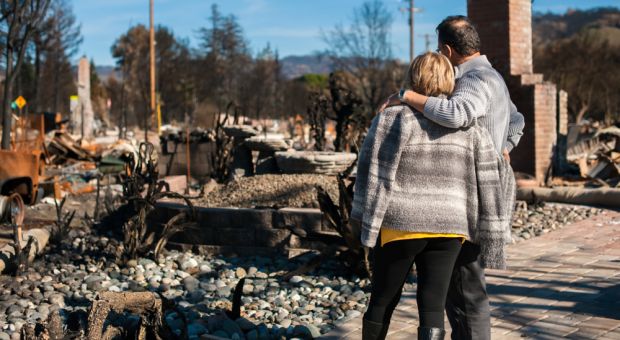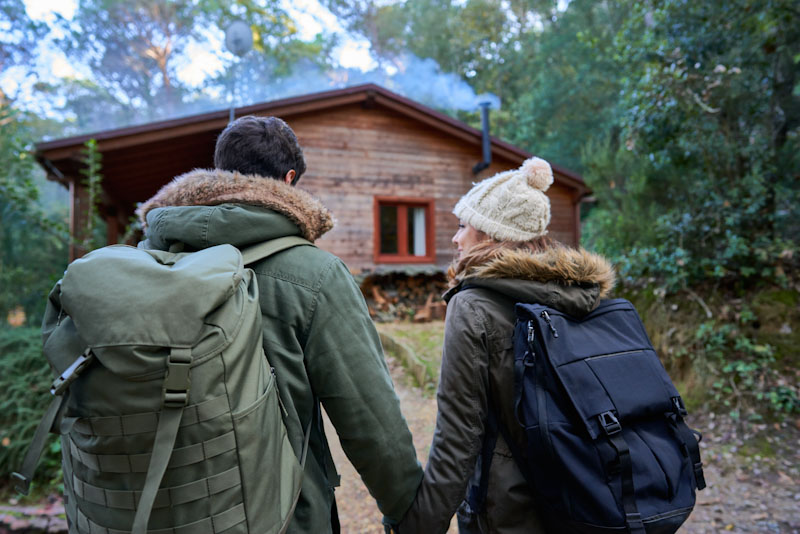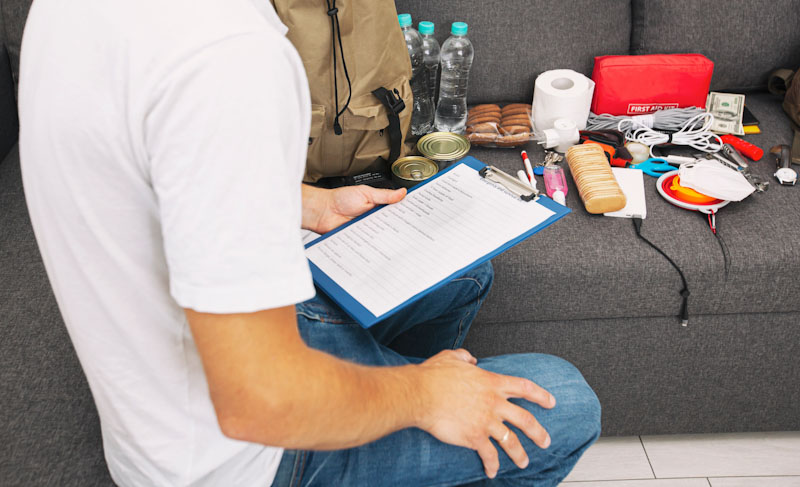We talk a lot about bugging out in the prepping and survival community, but we don’t really go much farther than the actual bug out itself, except to talk about survival retreats.
But, as we all know, not all of us can afford some cabin in the woods to use as a survival retreat. I’ve been taking a fresh look at the idea of bugging out, specifically looking for holes in our planning.
I’m going to start with the assumption that you’ve got a bug out plan in place. That has to include a destination and route to get there. Hopefully you’ve already got some supplies stockpiled in place, or if not in place, at least close by, where you can get to it easily. If you don’t have that, your bug out isn’t likely to succeed; those are just the basic essentials for any bug out.
This Timeless Collection of Forgotten Wisdom Will Help You Survive!
We all know that we can’t depend on driving in a bug out situation, although we probably have plans on doing just that. However, we recognize the possibility that we might have to abandon our vehicles, due to traffic jams, and head out on foot. So, we’ve planned for that too.
But what I want to deal with now, is what do we do when we get to our survival retreat, wherever that might be? Basically, there are four options for this, if we assume that none of us are willing to put our families in the hands of the government and go to a FEMA camp:
- Our cabin in the woods or other prepared survival retreat
- The home of a friend or family member, who lives in the country
- A hotel or other temporary dwelling
- Somewhere in the wilderness
While there are different things you will have to do in each of those situations, there are also things in common. Let’s look at those.
Security
The first thing you have to be concerned about is your personal security. Normally, this isn’t our highest survival priority, but if we’re talking about a mass evacuation, you have to be. At least some of the people who will be bugging out along with you, will be people with criminal tendencies. On top of that, the vast majority of people who are bugging out will be unprepared. As their resources run out, they will begin to become desperate.
While you should not appear to be overly aggressive, so as to avoid sparking an incident, you want to be ready and aware of what’s going on around you. Travel with your eyes open, in condition yellow, looking for any potential dangers. Keep an eye on any people you see, to ensure that they aren’t following you or trying to see where you are going.
As part of this you want to use deceptive traveling techniques, changing direction, looping back, going into dead-end canyons and then backing back out of them; essentially the same techniques that a spy would use in what is known as a “surveillance detection run.”
Scouting Your Retreat
When you arrive at your survival retreat, take the time to loop around it, checking it from all sides. While doing this, look into the location to see if there are any signs that anyone is there or anything is disturbed, as well as looking for tracks and other sign that would indicate that others have walked that way. One of the easiest signs to look for is broken twigs on trees and underbrush; animals never break those, only humans.
Once you’ve looped around the site, then move in closer and do another loop, looking for the same things. Keep your eyes open for anyone who might have beaten you to your retreat and be prepared to defend yourself from them, if that is the case.
Remember, anyplace you can find and turn into a survival retreat, others can find as well. Unfortunately, some of those people may not be all that concerned with who owns the property, especially if they are desperate and seeking the basic survival needs. It is even possible that you will have to evict people who are squatting on your property.
Finally, when you move in to enter, only have a couple of people to move close, while the others form an overwatch position to provide fire support, if needed. Then look to see if the doors or windows have been breached. Clear the building, as if it was being held by terrorists. Be slow to shoot, but not so slow that they have the opportunity to wound or kill any member of your party. You may be able to win the battle, without firing a shot, simply by having overwhelming firepower at your disposal.
Don’t Stop There
In a sense, this is a military exercise and you have to treat it that way. The methods I’ve just talked about for circling the property and entering it are the same as a long-range patrol would do, when arriving at a RON (remain overnight) site, deep in enemy territory. That’s how you have to treat it.
But it doesn’t stop there. The next thing that a long-range patrol would do is set up a perimeter defense. Even though you were watching your back trail, you can’t be 100 percent sure that nobody followed you. They might have done so secretly enough that you didn’t see them. So before doing anything else, you need to establish your defenses, making sure that you have guards posted, to look for anyone who might come to call.
Again, you don’t want to be too quick to shoot, as using deadly force in self-defense doesn’t include preemptive attacks. But you want to be looking to see who might be trying to approach your retreat and be ready to give them a warm welcome, if you need to.
Communications
One of the big questions you will be facing is how long you’re going to have to stay away from your home for. Will this be a short-term bug out, a long-term one, or will it be permanent? That’s going to depend on the reason why you had to bug out in the first place, as well as how the situation develops and is resolved. Most situations will eventually offer the opportunity to return home, assuming that your home does not get destroyed by the disaster.
But the only way you’re going to know when and if there is a possibility of returning home is if you find out what’s happening. That means having access to whatever news services there might be functioning during the disaster. If nothing else, Ham Radio operators will probably be communicating, giving you that means of receiving news, if you have a shortwave receiver.
If possible, you also want to maintain communications with whoever might be still in your old neighborhood. There are always people who are unable or unwilling to evacuate, even when the government tells them they have to. Know who these people are and work out some way of keeping in contact with them. They can serve as your eyes on the ground, telling you how things are back home.
Should the opportunity present itself to return home, do so with extreme precaution, sending a scouting expedition first, to determine the condition of your home and whether it is safe to return. These scouts should check the home, the neighborhood, availability of resources and make contact with your local spies, if possible. There’s no sense in moving back home, if you’re going to be better off staying in your survival retreat.
Resupply
Regardless of whether you are going to arrive at your survival retreat driving a vehicle or on foot, you are only going to arrive with a limited amount of supplies. So you are obviously going to need some sort of a plan for resupply. Whether this is through stockpiling your survival retreat ahead of time, establishing remote supply caches or living off the land, you have to have the necessary supplies, in order to survive.
If you have left supplies stockpiled at your survival retreat, you need to do so in such a way as to prevent looters from being able to access them. You must assume that they will break into your retreat and steal anything that is easily taken; so you can forget about keeping your supplies in the kitchen pantry, even if it is locked. Remember, locks only keep honest people honest; they don’t do much to stop those who are intent on committing a crime.
This means that you need a better means of storing those supplies, than just a locked door. One such possibility is a secret room, preferably a secret underground room, so that they can’t figure out that it is there as easily. A secret room depends more on deception to protect your supplies than a lock, but even so, be sure to design and build it with some good locks anyway.
One of the keys to preventing theft is to make it difficult enough that the bad guys give up and look elsewhere. There really is no perfect security system. All there is, are security systems that are hard enough to breach, that criminals decide to look elsewhere.
Another possibility, which takes advantage of this principle, is to use a shipping container as your supply storage. The typical shipping container comes with four latches, each of which can be locked separately. While that doesn’t mean that they can’t still cut the locks off the container, it would be four times as much work. If you use the round locks that are commonly used for storage areas, it’s even worse.
Don’t Keep All Your Eggs in One Basket
Regardless of how well you can secure your supply stash, it only makes sense to store at least some of your supplies off-site, either in caches or in a remote storage area. When selecting such a location, you want to make sure that it is within walking distance of your survival retreat, as you may have to go there on foot to retrieve your supplies.
This means that you will also need some means of carrying those supplies back to your retreat. A simple cart will do for this, and can either be kept at the retreat or with the supplies. Either way, it will give you the capability of carrying much more, than if you had to carry it in a backpack.
I would avoid bringing these remote supplies to your retreat, until you were reaching the point of needing them. You never know what might happen and you might be forced to abandon your retreat, especially if a larger group attacks you.
Build a New Life
Unless you know that you’ll be returning back home in just a few days, it is best to be thinking in terms of building an new life, rather than in just surviving for the moment. Even situations which look like they may only be short-term can easily turn into much more. When the people of New Orleans had to evacuate due to Hurricane Katrina, I’m sure many of them thought they would be back home in a week. Yet many of those homes were so badly damaged, there was no reason to return.
You and I could very easily face the same sort of situation, should we ever be forced to bug out. So, while our number one priority has to be surviving, we must also consider the long-term and plan for it. More than anything, that means working on more than temporary shelter and developing sustainable food sources.
There is a tendency in a survival situation to think only of the here and now. But if you allow yourself to stay in that mode, you will never get out of it. You have to take the effort to push yourself out of that mode and start thinking long-term. That can mean things as simple as if you need to carve a spoon, you should carve a good one that will last a while. It can also mean planting a garden as soon as possible, so that you will have food to harvest.
If you are bugging out to a friend or family member’s property, is that sustainable? Will they put up with you living with them for 10 years or more? If not, you’ll need to start thinking about your next stage. Where will you go from there? The same can be said if you are in a hotel. Those are expensive, so you don’t want to stay in one any longer than necessary.
Actually, your bug out plan should have this second stage built into it, even though most people don’t bother to think that far. But there’s nothing wrong with having a two-stage plan, where you bug out to get away from the danger, then move on to a more permanent solution to your family’s needs.
Returning Home
There is always the chance of returning home, unless your home has been destroyed or the area has been quarantined. Most of us would probably prefer this option, rather than staying in our survival retreat for the rest of our lives. While a cabin in the woods might be nice for a while, we humans are social creatures, intended to live in community.
But returning home should only be undertaken with extreme caution. As I mentioned above, send a scout mission first, to determine if it is safe to return. There is really no sense in returning home if your chances of survival are better at your retreat.
In addition to looking for danger, this scouting expedition also needs to be looking to see how easy it will be to survive, once you return home. What is the supply situation like? Have any services been restored? Are there supplies you will need, such as firewood, which will be harder to get in the city, than they are where you are? Are there “warlords” or gangs in control of the area? How many others are living there and what kind of shape are they in? Are people working together to survive or not?
All these questions and more should be going through the minds of the scouts, as they look over the situation back home. that information will be essential for determining if it makes sense to return or if you are better off where you are.
One of the key questions in that list was the one about warlords and gangs. It is said that nature abhors a vacuum and politics does so even more. Chances are, if there is a total collapse of society, that someone or some group of people will rise up to take control. These are not likely to be benevolent people, looking to help everyone out. Rather, it will be the strongest and meanest who will take control. You need to see who it is, preferably without getting caught.
Proceed with Caution
Just like you scouted your survival retreat, circling it far out and then closer in, you should scout out your home and neighborhood when you arrive. Clear each room in your home, as if you expected to find criminals there. Establish your perimeter defense. You may be able to relax that, once you have been home long enough to see how things are, but don’t assume it is safe, just because you are home.











Alibaba | September 18, 2018
|
Bullshit! I got a lot emails about what special ops, Navy Seals or green berets would do in an emergency situation! BUG IN! No surprise here, as I’m one of them! When enemy got the smell of you, and start shelling your position, the worst idea is to turn the back to them! So then they are circling you! What better target you can have than the back of a coward running away from you? A natural disaster is not much different! Just train to survive! After all, they are rescue teams on or after each disaster! How do they do it? Learn their tricks! If they can do it, so can you! But the first tip on that: THEY ARE NOT STUPID!… Keep that in mind!…
Carol j horvath | September 18, 2018
|
Thank you straight shooter.
How do you apply not being smart?
Dale Armelin | September 18, 2018
|
The #1 problem with all of your advice is blindingly obvious: You assume that one will be bugging out with a group. What if you are alone? All of your advice about sending out scouting parties, etc. goes right out the window. For that reason as well as many others, I agree with Alibaba — BUG IN. If your home is destroyed or rendered uninhabitable, find an abandoned structure close to home — hopefully, one that is easily defensible — and begin moving your stockpile, there. A commercial or industrial building would be the best choice as they would be more “hardened” than the typical family home or apartment. I could go on. The entire prepper community has been far too focused on bugging out. It has developed tunnel vision. More attention needs to be paid toward planning for bugging in, and that includes a short-distance bug-out to an abandoned structure. In a SHTF scenario, especially a TEOTWAWKI event, there should be plenty of commercial and industrial spaces available. Just be sure not to choose a place where food or other supplies would be stockpiled as you’d be sure to run afoul of scavengers/looters.
Ben | November 8, 2018
|
Maybe I’m wrong in this assumption, but when ever I consider the notion of bugging out, I always thought of it as a long term, possibly permanent situation. If it’s not long term or permanent why bug out in the first place? On the whole bugging in situation, how do you determine if it’s going to be short term, can get by with just stocking up supplies, versus needing to get something sustainable going? To be honest, the only bug out situation I can think of would be an EMP wipes out our power and electronics. Just curious on other thoughts. Don’t consider my self a prepper but would at least like some head knowledge on the off chance crap happens.